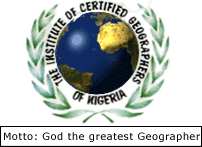|
JOURNAL
|
 |
|
THE CARDINAL POINT
|
|
GEOMATIC EDUCATION IN NIGERIA: PROBLEMS AND PROSPECTS |
|
By
Solomon Kogi Kaduna State College of Education, Gidan Waya P.M.B. 1024, Kafanchan, Kaduna State |
| Abstract This paper examines the introduction and development of Geomatic education in Nigeria. It has been found that Geomatic education is a metamorphosis from surveying to the integration of surveying techniques and its applications with modern methods of Global Positioning System (GPS), Remote Sensing and Geographic Information System (GIS). Geomatic education is offered in Universities, Colleges of Education, Monotechnics and Polytechnics and Technical Colleges. It is also available for apprenticeship and on the job training. The problems of Geomatic education include lack of facilities, poor funding and dearth of qualified teachers. If the government can promulgate a clear policy, provide adequate funding for training and purchase modern equipments and provision of facilities, provide career guidance at the post primary level, the prospects of Geomatic education would be greatly enhanced. For full details, click here to subscribe |
|
TRANSPORT DEVELOPMENT IN NIGERIA: PROBLEMS AND PROSPECTS By Marcellinus Zirra Station Manager, Nigerian Railway Corporation, Kaduna e-mail: Zirramarcell@yahoo.com |
| Abstract The study assessed development of rail transportation in Nigeria and made appropriate recommendations in improving the performance of our rail system. The Nigerian Railway Corporation was an asset to the nation during much of the colonial era but has since become a liability as far as its financial performance from passengers and freight services are concerned. This Write up investigates a number of reasons responsible for the steady ineffectiveness of the Corporation from the Onset of the teething period and prescribed proposals for alleviating these problems. The government and most Authorities concern are aware of these multifarious problems which are gradually ruining the existence of the Corporation. From the outset till 1995 the corporation has witnessed fifteen (15) Committees, Commissions, Studies or tribunals set up to investigate her problems but none of these reports have seen the light of day. For full details, click here to subscribe |
|
URBAN CIVIL CONFLICTS AND POPULATION REDISTRIBUTION IN KADUNA METROPOLIS: |
|
By
L.O. Enukora Associate Professor, Dept of Geography, Nigerian Defence Academy NDA P.M.B 2109 Kaduna |
| Abstract This paper explains the problem of managing full- blown, urban civil conflicts in Nigeria using the, Ethno-religious violence in Kaduna metropolis in 2000 as a case study. It employed the field survey approach, characterized by observation, instrumentation, and measurement and mapping to uncover a binary formation, namely, the conventional and the spontaneous, in the management process. It went on to demonstrate that the application of the conventional system to the management of Kaduna ethno-religious violence had mixed results: the rapid response approach was evidently flawed while the recovery and mitigation exercises were found successful and commendable. The spontaneous process, characterized by population redistribution and areal differentiation, was shown to be novel, responsive and practical but, nonetheless, fraught with dangers. Based on the findings, the paper made recommendations to the stakeholders on ways and means of managing ethnic and religious violence. For full details, click here to subscribe |
|
APPLICATION OF REMOTE SENSING AND GIS FOR MONITORING AND MAPPING OF AFAKA FOREST RESERVE OF NORTHWESTERN NIGERIA
|
|
By
Maisamari J.I. Akinyemi O., Mannir S. I. and Guyitson P.g.. Department of Forestry Federal College of Forestry Mechanisation, P.M.B. 2273 Afaka, Kaduna, Nigeria saacmaisamari@yahoo.com Abstract |
|
LAND MANAGEMENT AND URBAN DEVELOPMENT IN NIGERIA: ISSUES AND PROSPECTS By Adamu Dabo Sambo No 1 Junaidu Yahaya Road, Off GGSS Kawo Road Kaduna Nigeria Fax/Tel: 234-62-3164730 Mobile 08037030279, RC 334661 Email: info@palmasmabera.com |
| INTRODUCTION As the process whereby Urban Centers develop is commonly referred to as urbanization (I), the process itself is characterized by several changes, notable among them are: increase in population, increase in physical development i.e. Buildings and Infrastructure, increase in Social and Economic activities. Urban centers in Nigeria usually develop gradually over time from small settlement to large settlement to small town then to urban center e.g. Ibadan (2) which started as a traditional political settlement as well as a small trading center, later became a focal center of politics and trade between regions and later developed in a large urban center. Urban centers in Nigeria (3) have characteristics, each peculiar in several ways due to the historical development of the centers. Basically we shall take two perspectives in looking at the characteristics of urban centers in Nigeria. For full details, click here to subscribe |
|
AN EXAMINATION OF THE RAINFALL AND DISCHARGE TREND OF RIVER |
|
By
Folorunsho, Joseph Olaniyi Geography Department, Ahmadu Bello University, Zaria, Kaduna State. Tel: 080336411562, 08056311986. E-mail:funshojoseph@yahoo.com |
| Abstract The study seeks to examine the annual rainfall – discharge trend of river Kaduna. Both parameters were subjected to a ‘smoothing operation’ i.e. a time series analysis of five and ten year running mean in order to authenticate the rainfall effects on the discharge. The discharge trend was found to be following the same downward trend as that of the rainfall, though with just little but intermittent variance, which is still a reflection of the basin characteristics, particularly that of the rainfall within the catchment area. This will have serious implications for municipal water supply if nothing is done urgently, in view of the growing population of Kaduna city and particularly with no dam across the river water at the metropolis. For full details, click here to subscribe. For full details, click here to subscribe |
|
Editorial Note Today, this dream is fulfilled. It is my pleasure to introduce to you the CARDINAL POINT Journal. Finally, I like to express my profound gratitude to all members of the CARDINAL POINT interim committee for their commitment to this cause. Also, I like to thank all who contributed to this edition for the quality to their papers. We accept responsibility of any unspotted error that may have occurred during the editing process. We also welcome suggestions on how to improve on the quality of this journal. It is our hope that readers will find this material helpful.
|
Nav Menu
Membership Categories
Contact Us
The Institute of Certified Geographers of Nigeria
BZ 1 & 2 Sardauna Crescent
Off Junction Road, 1st Floor, ICEN Wing,
P.O.Box 4333, Kaduna
GSM :08080860650, 07034727007, 08133080404
WhatsApp: 08029139010
E-MAIL:
certifiedgeographers@yahoo.com


